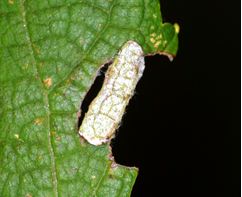Grape Berry Moth Predictive Model
The grape berry moth (GBM) larva is a key pest that can cause serious damage to grapes. The larvae damage commercial vineyards by feeding on the grape blossoms and berries. Infested berries may appear shriveled with fine webbing. Damage increases mold, rots and numbers of fruit flies in both wild and cultivated grapes. There may be 3 or more generations per year.

Figure 1. The adult moth (Moth photo credit: R. Isaacs, Michigan State University) is small, active, and about 1/4 inch long. At rest with its wings folded, there is a brown band across the middle of the moth’s wings, the hind portion is gray-blue with brown markings, while the front portion is gray-blue without markings. The full grown larva is 2/5 inch long, pale olive-green, and can have a purplish tinge from the food it has eaten.
GBM overwinters as a pupa in leaf litter. Adults emerge and lay eggs of the first generation near bloom time. This degree day model can be used to time application of insecticides to reduce GBM injury. The degree day requirements were developed by Cornell, Penn State and Michigan State Universities. GBM needs 810 DD base 47°F to complete a generation. The date to begin accumulating degree days is when 50% of the wild grapes near the vineyard are at 50% bloom. Egg laying for the second generation begins at 810 DD and for the third at 1620 DD. Generally, sprays are applied 200 DD after the start of egg laying (200, 1010, and 1820 DD after wild grape bloom) for most insecticides, but the insecticide growth regulators (Intrepid) that are applied at egg laying should be timed for the biofix date, 810, and 1620 DD.
Degree day targets for the various
codling moth insecticides
